“The Lone Ranger” Rides Back With Great First Issue
By Mark Wheaton
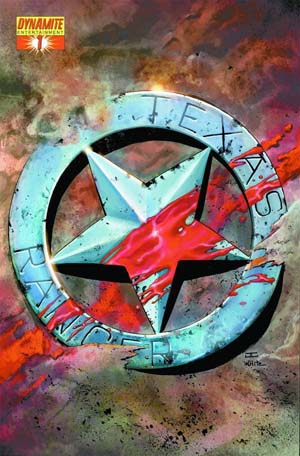 “The stump…you cut the tree down to build the house. It doesn’t mean you don’t miss the shade.”
“The stump…you cut the tree down to build the house. It doesn’t mean you don’t miss the shade.”
Full disclosure: When people talk about their childhood things – “G.I. Joe” toys, the kind of Underoos they favored or, most specifically, the lunchbox they dragged to school, most of my friends lay claim to “Battlestar Galactica” or “Star Wars” boxes, the metal kind with the thermos that clipped into the box and rusted when you spilled too much milk.
Well, mine was for “The Lone Ranger” – the only such one at my elementary school, a surprise seeing as how I did my grade school in
Dynamite’s recent licensed lines have been kind of touch-and-go. As many good entries in the “Army of Darkness” comic line as there are, there are just as many bad. “Battlestar Galactica” is interesting, but no classic yet – same with “Highlander.” But now “The Lone Ranger” comes along with the first, just really good Dynamite licensed book that looks to retell the “Lone Ranger” saga in a no-holds-barred, wildly violent western way that could be a truly great new monthly.
In issue #1, we’re introduced to John Reid aka The Lone Ranger with a well-done origin tale that cuts between his boyhood, his relationship with his brother Dan and – finally – the massacre that killed his family (all Texas Rangers) soon after John returns from his “schoolin’” back east. And in the last panel, ***SPOILER WARNING*** we meet Tonto.
There have been a lot of great western books lately (including this week with the horror western “Bad Moon Rising”) with the Mighty Marvel Westerns and – especially – “Jonah Hex,” but there’s always room for more. With “The Lone Ranger,” writer Brett Matthews and artist Sergio Carriello come together with a really great looking book that also tells its story quite well. There’s really not a missed step here in issue #1 – not only is a solid origin story, it’s also the set-up to a cool western action tale and is simply trying to introduce the Lone Ranger to a new generation of western fans, not reinvent the wheel in a completely different direction as is happening in a lot of books.
Very impressive. As a Texan, you may say I’m biased, but the truth is, it just means I’d be a lot more likely to come down like a cyclone on a bad version.
RATING: 
Mystery In Space #1: Contemplating Captain Comet’s coolness
By Graig
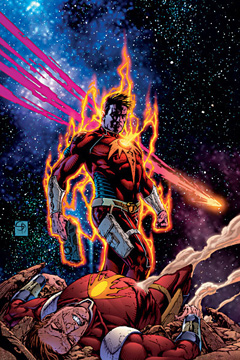 Jim Starlin has been crafting space faring adventures for decades now, with a modest resume including the Infinity Gauntlet, Cosmic Odyssey, and Dreadstar, also credited as having created Adam Warlock and Thanos. His repertoire is almost exclusively space-centric, and, to be honest, I’ve read very little of it. Perhaps it’s prejudice on my part, seeing Starlin as a one-trick pony who can only deal with off-planet characters, or perhaps I find most of the Marvel and DC Universe’s intergalactic heroes are generally unappealing. But with the awesome Annihilation mini-series over at Marvel, a nifty Adam Strange mini-series that preceded events of the Infinite Crisis, and a newfound fondness for the Legion of Super-Heroes, I’ve come to really enjoy the stars in the night sky, so I gave the new 8-part Mystery In Space series a shot.
Jim Starlin has been crafting space faring adventures for decades now, with a modest resume including the Infinity Gauntlet, Cosmic Odyssey, and Dreadstar, also credited as having created Adam Warlock and Thanos. His repertoire is almost exclusively space-centric, and, to be honest, I’ve read very little of it. Perhaps it’s prejudice on my part, seeing Starlin as a one-trick pony who can only deal with off-planet characters, or perhaps I find most of the Marvel and DC Universe’s intergalactic heroes are generally unappealing. But with the awesome Annihilation mini-series over at Marvel, a nifty Adam Strange mini-series that preceded events of the Infinite Crisis, and a newfound fondness for the Legion of Super-Heroes, I’ve come to really enjoy the stars in the night sky, so I gave the new 8-part Mystery In Space series a shot.
The book is comprised of two serials, the main feature starring Captain Comet, and the back-up feature starring The Weird. Captain Comet has always held a strange fascination for me ever since I first read about him in Who’s Who back in the mid-80’s. He’s a powerhouse in the DC Universe, but wholly underutilized, making very few appearances over the past three decades, save for a few issues of the Secret Society of Super-Villains, a regular supporting role in L.E.G.I.O.N. and his recent return in the Rann-Thanagar War. As comic’s first mutant superhero (originally created in 1951, he predates the X-Men by more than a decade), he doesn’t really get a lot of attention, but he hasn’t really deserved it either. Starlin’s resurrection (literally) of Captain Comet in Mystery In Space is an interesting one but I still don’t think, despite a new look, that it’s going to set fandom on fire.
The lead story is primarily exposition, filling the reader in on who Captain Comet is, how he died, and how he survived his own death, the actual “mystery” in space hasyet to reveal itself. As far as exposition goes, this is 22 pages of quite interesting stuff, Starlin cutting between Comet’s first person telling and some commentary from his supporting cast. The art by Shane Davis and Matt “Batt” Banning is top notch, with amazing colors provided by Jeromy Cox.
The backup feature is puzzling, as it features the Weird, a fully disposable character Starlin created for a 4-issue mini-series back in 1988 and hasn’t been seen since. I don’t know that there was any demand at all for a return of the character, or any need for a follow-up story. As with the main feature, Starlin uses his 16 back-up pages for exposition, retelling the Weird’s story and highlighting his resurrection (which ties in with the lead feature). The differences between the fore and the back pages are astonishing, as the Weird just isn’t very interesting (nor pretty to look at) and his revival is uninspiring. Starlin handles art chores as well on this story, starting with 7 dull pages of twinkling stars. The final page gives the story some direction but I’m still not enthused.
Mystery In Space, for its price tag of $3.99 gives a lot, but would be better as a cheaper, Captain Comet only book or perhaps an anthology with another writer handling the backup story. With service given to Starlin’s failed creations like Hardcore Station and the Weird, it strikes me as just too much of a vanity project to fully recommend.
RATING: 
Life on some very mean streets: The Cross Bronx #1
By Jeb D.
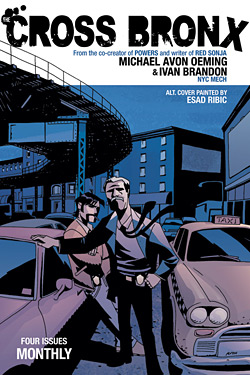 The Cross Bronx is a new 4-issue miniseries from artist/writer Michael Avon Oeming, with co-writer Ivan Brandon, beginning this month from Image. While Oeming is starting to make a name for himself as a writer, those who love his artwork on Powers will find themselves on very familiar ground in this excellent debut issue.
The Cross Bronx is a new 4-issue miniseries from artist/writer Michael Avon Oeming, with co-writer Ivan Brandon, beginning this month from Image. While Oeming is starting to make a name for himself as a writer, those who love his artwork on Powers will find themselves on very familiar ground in this excellent debut issue.
Detective Rafael Aponte works in a New York whose brutality has stripped him of whatever faith he might have once had in human decency; he can’t even bring himself to attend church with his wife anymore. He’s called to the scene of the city’s latest obscenity: a grisly multiple murder taking out members of a Hispanic drug gang. Tracing the gun used, he finds it was originally owned by a cop who died in the line of duty years back, and that first step sets him on the road to an investigation that we assume will help him to restore some missing piece of his soul. Only, things aren’t that simple: the dead cop’s wife has a story to tell that is the last thing he expected to hear, and his interview with her piles even more misery on his shoulders. In the meantime, there’s another gang-related murder: this time we see the killer, and it’s now clear that things are REALLY not what we, or Aponte, expected.
To say much more would not only spoil some surprises, but it would do nothing to convey how much of the book’s strength lies in Oeming’s artwork, and his ability to convey a glance or a thought over a series of panels, and capture that moment in time in a way that is unique to comics: Aponte’s study of a religious card of the Virgin Mary might be a flicker of a moment, or a long pause—a film or TV director would have to force that timespan on us. Oeming allows us to make that choice ourselves: Aponte studies the card as long as the individual reader needs for the moment to sink in.
The look and feel of the book owe a lot to Oeming’s work on Powers, and that’s fine—it’s not “typecasting” for an artist this good to bring his strengths to similar projects. As with Powers, he undercuts the somewhat cartoony art with a brutality that might even surprise viewers of TV series like The Shield or Homicide—this is decidedly not a book for the weak of stomach.
26 pages of story, plus an amusing collection of rejection letters from Oeming’s early career, for $2.99. This is what we call value for money; certain other comic book publishers might take note.
The police procedural has worked as a popular entertainment for many decades, because the strength of the story is always in the details of the telling, the characters, and what they (and we) can learn about the human condition along the way. Cross Bronx is a particularly compelling example of the genre.
RATING: 
Carnival of the mundane: American Splendor returns
By Graig Kent
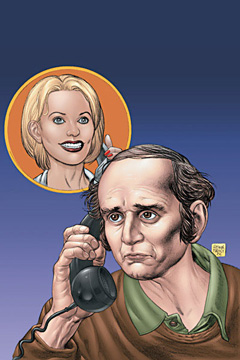 Harvey Pekar has been writing his American Splendor comic sporadically for over thirty years. For the bulk of that time it’s been an underground staple, Pekar gaining some minor notoriety from a handful of guest appearances on Late Night with David Letterman, but hardly lifting him to any sort of celebrity status. In the early nineties, the book received a small push by publishing under the masthead of Dark Horse Comics, but despite no longer being self-published, American Splendor was still a tough sell. The real-life stories of a Cleveland-based file clerk? Not exactly a draw to the spandex-tights crowd.
Harvey Pekar has been writing his American Splendor comic sporadically for over thirty years. For the bulk of that time it’s been an underground staple, Pekar gaining some minor notoriety from a handful of guest appearances on Late Night with David Letterman, but hardly lifting him to any sort of celebrity status. In the early nineties, the book received a small push by publishing under the masthead of Dark Horse Comics, but despite no longer being self-published, American Splendor was still a tough sell. The real-life stories of a Cleveland-based file clerk? Not exactly a draw to the spandex-tights crowd.
However, after the 2003 release of a film based on Pekar’s works, featuring a star-turning performance from Paul Giamatti, an Oscar nod for best adapted screenplay, and fourth-wall busting sensibility which showcased the actual people behind the characters finally raised his recognition factor. Now American Splendor returns with a new four-issue mini-series from one of the majors, DC Comics’ Vertigo imprint.
While I’m still trying to understand the point to it being a mini-series (since AS has always been an anthology rather than a series of connecting stories), this is patented Pekar, showcasing all his neuroses, discussing openly his family life (here recounting the story of his parents), and highlighting humorous situations that have occurred around him. If you’ve never stepped into Pekar’s world before, this is as good a place as any to start (but really, you can start anywhere).
Pekar has always managed to find some good artistic talent to accompany his work, and Vertigo has wisely allowed these collaborations to continue, with Dean Haspiel and Gary Dumm (with Greg Budgett) each taking a story. Vertigo has also tossed some of their frequent collaborators onto the project as well, with Ty Templeton and Hilary Barta also tackling a story or vignette each and Glenn Fabry taking cover chores.
For fans of American Splendor, nothing has really changed except a slicker package. For the curious filmgoer or open-minded newcomers, you will find yourself immersed in a character that is both hilariously and painfully real. A unique comics experience every time.
RATING: 
Odds Bodkins! Marvel continues to milk 1602 with Fantastick Four #1
By Jeb D.
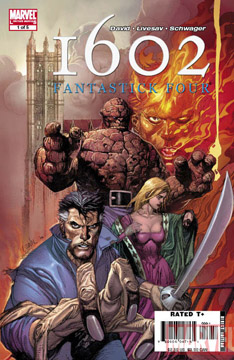 Neil Gaiman’s a smart guy, who knows how the comics business works. It stands to reason that he must have expected Marvel to try to expand on the franchise he created with the success of his 1602 miniseries. So far, he seems to have kept his opinions on that to himself; maybe it’s best that way.
Neil Gaiman’s a smart guy, who knows how the comics business works. It stands to reason that he must have expected Marvel to try to expand on the franchise he created with the success of his 1602 miniseries. So far, he seems to have kept his opinions on that to himself; maybe it’s best that way.
1602 reproduced many of Marvel’s most familiar superheroes and villains in pre-colonial England and America. It gave Gaiman a chance to play with the vintage Stan Lee versions of his favorite characters in the kind of period setting that had marked much of his run on Sandman. It was a pleasant enough trifle, dramatically illustrated by Andy Kubert. Largely on the strength of Gaiman’s name it became a major sales hit. And we all know where that leads.
The first attempted followup, the 1602: New World series was written by Greg Pak, one of Marvel’s up and coming new writers. It sank pretty much without a trace. This time out, veteran Peter David is given the task of mining this property for more gold, and while the first issue isn’t really a bad story, there appears no immediate danger of the “1602” universe becoming Marvel’s next cash cow.
The book opens with the “fantastic” story of an adventure of the 1602 version of the Frightful Four, culminating in the Wizard’s vision of a “city of miracles,” and David gives it the full flowery narrative of a tale told over a tankard in a tavern– which is where the Wizard and Medusa find themselves confronted by the faceless armored minions of one Otto Von Doom. It would seem that Doom is collecting various strange and powerful beings for his own uses, and the Four are “persuaded” to accompany them.
From there, we’re introduced to two of the most famous men of the age, one whose power resides in words, the other in “divine right”: Master Will Shakespeare is receiving dramatic criticism from King James I (Queen Elizabeth having died in the original miniseries). It’s amusing; probably the high point of the book, as David conveys the frustration of the artistic temperament forced to compromise with the power of patronage. As a familiar-looking member of Shakespeare’s acting company looks on, the next part of Von Doom’s plan is hatched, and we’re treated to the sight of a rocky-looking, orange-colored “Falstaff” doing battle with Doom’s antique version of an air force. Of course, since this is only issue 1, Ben’s not able to thwart the villain’s plans. But as Sir Reed Richards prepares to send the Fantastick Four into action, his wife Susan brings him news that may well mean the end of the Jacobean superteam.
Artist Pascal Alixe had a tough act to follow: Andy Kubert’s moody pencil work gave the original series much of the weight that the script seemed to lack. Alixe seems to be going for a sort of faux-wooodcut approach here, and while it has is effective moments (the storm that ensnares the Frightful Four’s vessel, Doom’s minions and his fantastic airship), it has a tendency to make faces look half-finished and indistinct. I’m also disappointed that, as with the Ultimate universe, the 1602 Medusa is transformed into the most obvious thing imaginable: a snake-haired gorgon. Throughout, though, the art does convey the strangeness of the setting.
Marvel’s had a surprisingly strong run of miniseries lately (like Ares and Daughters of the Dragon), and I think David’s giving this one a good shot, but this whimsical outing feels even less compelling than the original 1602 series did.
Oh, and by the way, the death knell of the $2.99 comic continues to sound (remember when that seemed an outrageous price? Like last year?): this book is $3.50, and offers nothing more than a cardstock cover for your extra four bits (it’s only adding insult to injury that the cover, by Lenil Yu, is more striking than the interior art). I’m docking it a half-point for that alone.
RATING: 
![]()

Lions, Tigers and Bears vol.1: Fear and Pride
(Image Comics)
by Graig Kent
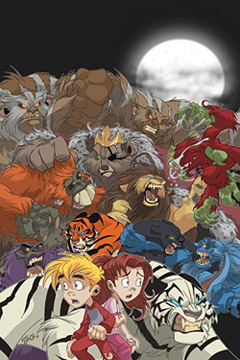 I grew up reading comics, as I’m sure most die hard readers did, but growing up in the 1980’s, I’m almost certain my generation was probably the last to be able to. As I grew up, so too did comics, as it seemed like my generation had a really difficult time letting go of its childhood (and still does, just look at all the resurgences of 80’s cartoons/toys like GI Joe, He-Man and Transformers): we wanted comics to reflect our teen angst and hormones in the 90’s (hence the grim’n’gritty/bad girl phase) and now we want comics to have complex storytelling and characters (today’s age of sweeping arcs and writer-centric sales). Unfortunately what’s been lost is a wealth of stories for children, since most titles, superheroes included, are geared towards the teen-plus market. But that’s not to say there isn’t anything out there for kids, but I understand why it’s so easy to overlook them. The current bulk of kids books are so directed at being kid-friendly that they almost pander, making them a tough sell for the comic fan looking for something suitable for their youngster but also appealing to them as well. This is where Lions, Tigers and Bears comes in.
I grew up reading comics, as I’m sure most die hard readers did, but growing up in the 1980’s, I’m almost certain my generation was probably the last to be able to. As I grew up, so too did comics, as it seemed like my generation had a really difficult time letting go of its childhood (and still does, just look at all the resurgences of 80’s cartoons/toys like GI Joe, He-Man and Transformers): we wanted comics to reflect our teen angst and hormones in the 90’s (hence the grim’n’gritty/bad girl phase) and now we want comics to have complex storytelling and characters (today’s age of sweeping arcs and writer-centric sales). Unfortunately what’s been lost is a wealth of stories for children, since most titles, superheroes included, are geared towards the teen-plus market. But that’s not to say there isn’t anything out there for kids, but I understand why it’s so easy to overlook them. The current bulk of kids books are so directed at being kid-friendly that they almost pander, making them a tough sell for the comic fan looking for something suitable for their youngster but also appealing to them as well. This is where Lions, Tigers and Bears comes in.
With shades of classic kid-lit like Alice In Wonderland and Chronicles of Narnia, as well as child-friendly anthropomorphism ala Lion King or Monsters Inc., Lions, Tigers and Bears feels like rediscovering something from your own childhood. It has familiar overtones, but the story is fresh, and characters are new. When his mother gets a new job, young Joey has to move away from his familiar surroundings, no longer having his friends or Grandmother close by. But his Gran gives him something to help keep him company: a quartet of stuffed Pantheras, which, if placed at the four corners of the bed, will keep the bad things away at night. But it’s not just superstition or childhood fantasy, as Joey finds out, as one night some mean gorillas come out of the closet and try to get him. His four new friends save him, but unwittingly bring him back with them to their dimension, where stuffed animals become real.
Writer Mike Bullock establishes a rich but simplified history to this alternate dimension, and his roster of characters are well fleshed out, having archetypal qualities without being clichés. Volume 1 is a fantastic introduction to the LT&B realm, and is a brilliant all-ages read. The art by Jack Lawrence is vibrant and fantastic, panel after panel of cel animation quality art. Both in story and visual presentation, it’s better than anything Disney has put out in the past decade (aside from Pixar, naturally), and looks and reads as sharp, energetic and engrossing as a Studio Ghibli story. Highly recommended for all ages.
5RATING: 
The King
(Top Shelf Productions)
By Elgin Carver
 Those immature in either age or thought or emotion often believe that sex, foul language and graphic violence is not only the intent of the phrase "adult content" but the sine qua non. While these actions and content may be subsumed within the concept, there are truly adult subjects much deeper and of greater import. Why are we here? Where are we going? Is there a God?
Those immature in either age or thought or emotion often believe that sex, foul language and graphic violence is not only the intent of the phrase "adult content" but the sine qua non. While these actions and content may be subsumed within the concept, there are truly adult subjects much deeper and of greater import. Why are we here? Where are we going? Is there a God?
Due partially to the inherent limitations of space and size, comics usually do not seriously investigate these questions. When they do, the limitations of the audience ( in the past age and education, and today, attention spans and absolutely rapt dedication to superheroes) reduce the view of these questions to such a narrow span as to make the reading experience practically childish.
In the 60’s, the appearance and evolution of the underground comic movement began to make it possible for comic artists to look into these questions in a hippie-dippie, dope induced hallucination sort of way. The evolution of the business of selling comics has advanced (?) to what we see today, creating the possibility of and demand for the graphic novel, which allows for a more in depth story. Sometimes this combination of situations meets with an artist whose viewpoints and interests allow for an adult exploration of deeper questions than "who would win in a fight between (insert your two or more favorite superheroes here)."
A man appears who may or may not be Elvis returned to bring hope and salvation to us all. Some believe and some do not. An investigative reporter comes to Las Vegas where The King is holding court and seeks "the Truth." Whether he finds it, can find it, or even if it exists are questions that are cleverly exploited, as well as those of the place of faith, religion, and hope in modern life.
We get few enough of these sorts of books in today’s market. This is worth the effort to track it down.
RATING: 
B. Krigstein Vols. # 1 & 2
(Fantagraphics Books)
By Elgin Carver
 The two most difficult questions to answer in the creative world is "What is Art" and "Who is an Artist." Some say beauty is in the eye of the beholder, and by extrapolation, the creator of beauty is an artist. Some look for content. Others look for style. People who ask the serious questions will look to the aesthetics of the work, sometimes applying differing standards to different types of work. Comics and other types of illustrations have always stood at the bottom of the totem pole in any such discussions. Often this is because of the intent of the artist, but more commonly it is because of the amount of talent, the quality of the talent revealed in the work.
The two most difficult questions to answer in the creative world is "What is Art" and "Who is an Artist." Some say beauty is in the eye of the beholder, and by extrapolation, the creator of beauty is an artist. Some look for content. Others look for style. People who ask the serious questions will look to the aesthetics of the work, sometimes applying differing standards to different types of work. Comics and other types of illustrations have always stood at the bottom of the totem pole in any such discussions. Often this is because of the intent of the artist, but more commonly it is because of the amount of talent, the quality of the talent revealed in the work.
Most comic fans want the medium to receive the same level of acceptance as other art forms; painting, printmaking, sculpture, drawing, commonly known as the studio arts. This acceptance has been sparse and generally limited to small segments of exceptionally talented individuals’ works, excised from the whole and expanded in size. Fans want the whole work to be accepted and appreciated. The barrier to that acceptance is, and it can only be said bluntly, a lack of talent seen in the work. If we look at the writing, novelists and poets are clearly better word smiths. If we look at the visual portion, we can easily find "fine artists" whose work is clearly superior. In the main, this is because those involved in comics simply are not as talented, although the limitations of the medium, size, manner of creation, and commercial considerations sometimes stand in their way.
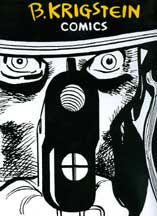 Classically trained, Krigstein moved effortlessly between the world of fine arts and the illustrative arts. The first volume in this set, details his life and work with hundreds of color illustrations of oil paintings, watercolors, and pen, brush, and pencil drawings, all exhibiting talent any fine artist would be proud of. The number of artists who have worked in the comics field and moved on to the world of fine arts can be counted on one hand. Those that have moved in the opposite direction can be counted on one finger.
Classically trained, Krigstein moved effortlessly between the world of fine arts and the illustrative arts. The first volume in this set, details his life and work with hundreds of color illustrations of oil paintings, watercolors, and pen, brush, and pencil drawings, all exhibiting talent any fine artist would be proud of. The number of artists who have worked in the comics field and moved on to the world of fine arts can be counted on one hand. Those that have moved in the opposite direction can be counted on one finger.
The second volume consists of reprints of entire comic stories by Krigstein. You may find some from the EC work that you have seen before. Most are from other publishers , MLJ, Fawcett, Pines, National, Hillman, Atlas, that will be unfamiliar. The first volume shows what a truly overall talented artist he was. A painter that turned to comics for money to feed his family. His work at EC was clearly superior and was, for the time, pushing the envelope. He eventually left comics for better paying commercial illustration work. Later he returned to the fine arts field with a successful career concentrating on oil painting. Had he found some way to meld the aesthetics of the fine arts world with that of the comics, perhaps the critical evaluation of the genre we all love would be further advanced than it is. In any case this set is an excellent review of an almost uniquely talented comic book artist.
RATING: 